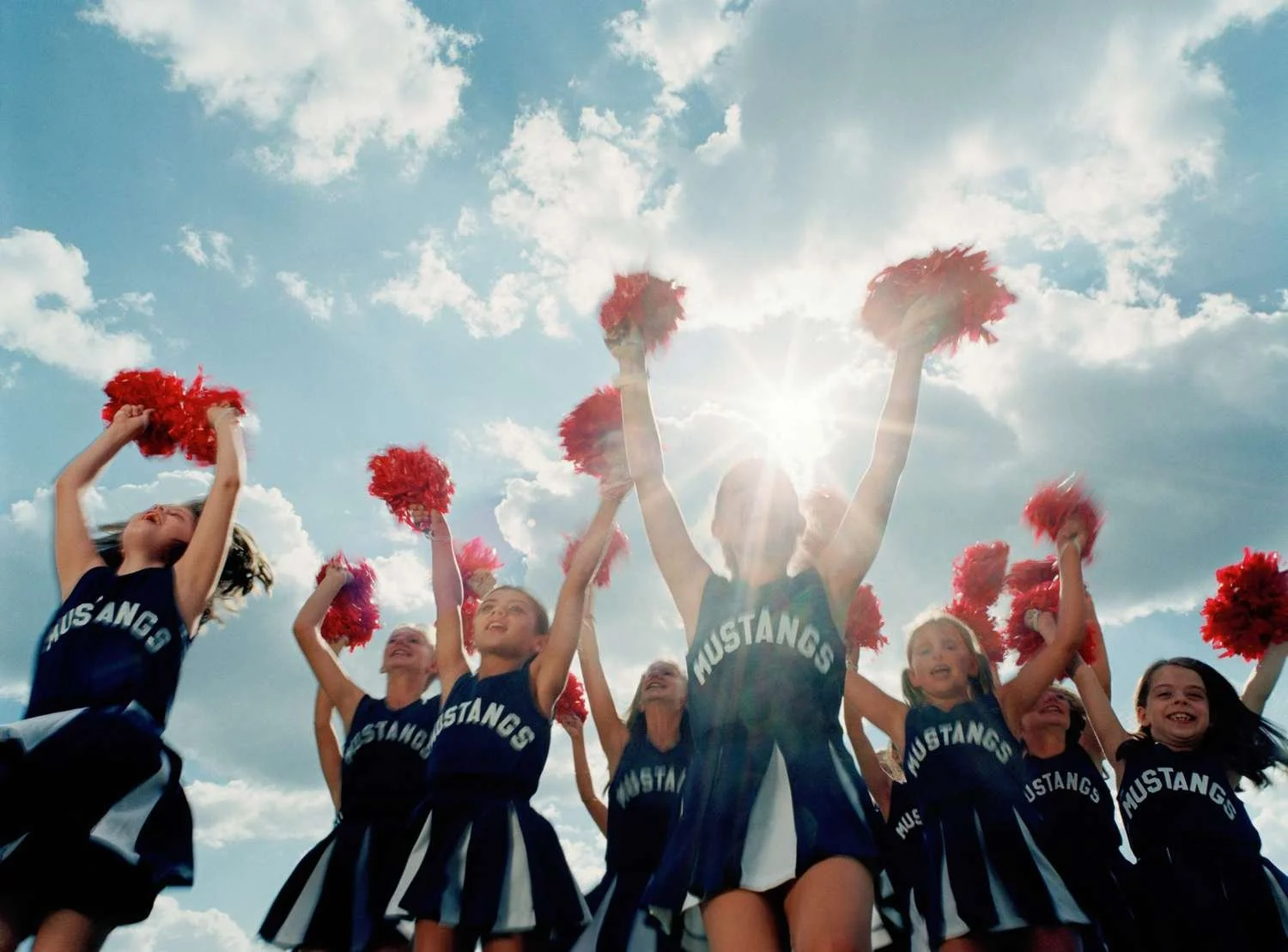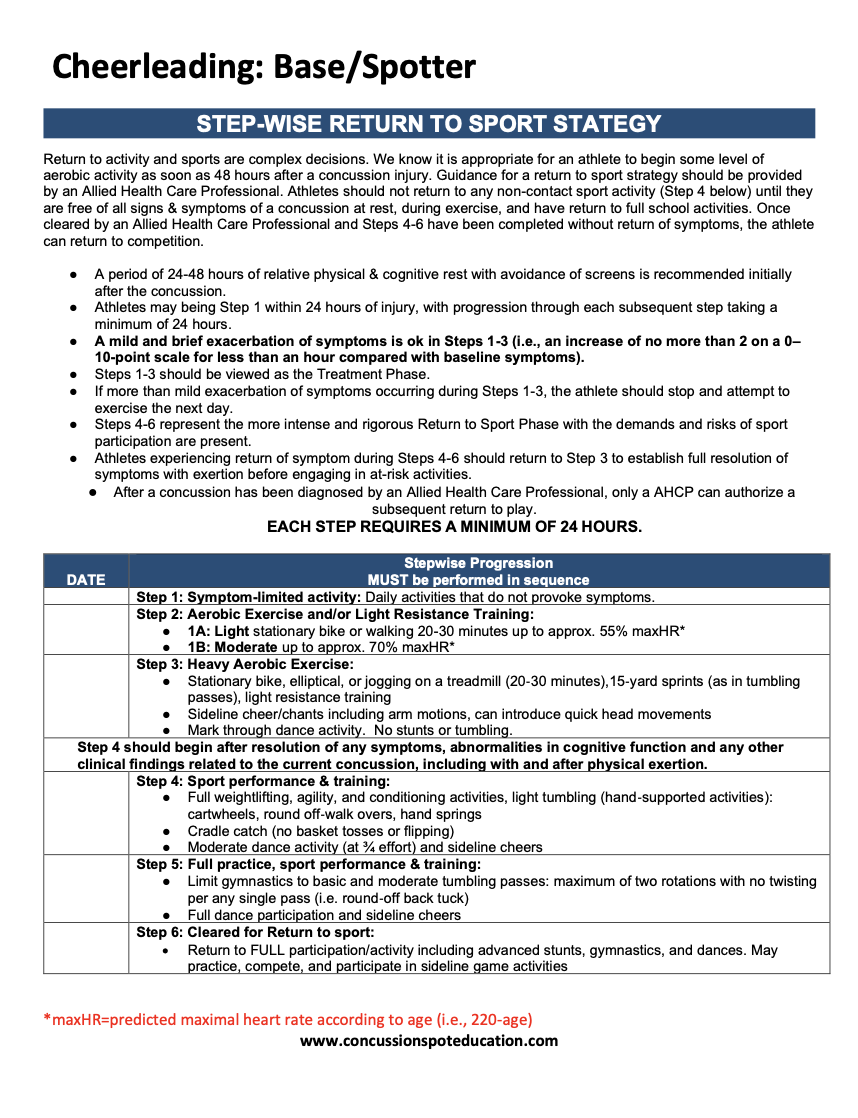

Cheerleading (Base-spotter) Concussion RTP Protocol
The Cheerleading (Base-Spotter) Concussion Return-to-Play (RTP) Protocol is a specialized recovery plan designed specifically for bases and spotters who have experienced a concussion. Bases and spotters play a critical role in cheerleading stunts by providing strength, stability, and safety support for flyers during lifts and tosses. Because of the physical demands and risks involved—such as heavy lifting, quick reaction times, and close contact—this protocol addresses the unique challenges faced by these athletes in safely returning to play after a concussion.
This protocol guides athletes through a structured, stepwise recovery process, starting with symptom-limited rest and light daily activities to allow initial brain healing. Once symptoms stabilize, the protocol introduces low-impact aerobic exercise to boost overall fitness without triggering symptoms. As recovery progresses, balance, coordination, and strength exercises off the mat are incorporated to restore neuromuscular control critical for supporting flyers.
Next, controlled dryland drills focusing on lifting mechanics and reaction time are introduced, preparing bases and spotters for the physical demands of their roles without direct partner interaction. The following phases gradually reintroduce partner work, starting with simple stunts at reduced intensity and complexity, with close monitoring for any symptom return.
The final phase allows full return to all stunt activities, including complex lifts, tosses, and spotter responsibilities, once the athlete remains symptom-free during exertion and has received medical clearance.
At every stage, athletes must be symptom-free for at least 24 hours before progressing. If symptoms recur, the protocol advises stepping back to the previous stage for further rest and evaluation.
Designed for athletes, coaches, trainers, and healthcare providers, this RTP protocol ensures a safe and effective return to the demanding roles of base and spotter, prioritizing brain health while rebuilding strength, coordination, and confidence essential for cheerleading safety and performance.
The Cheerleading (Base-Spotter) Concussion Return-to-Play (RTP) Protocol is a specialized recovery plan designed specifically for bases and spotters who have experienced a concussion. Bases and spotters play a critical role in cheerleading stunts by providing strength, stability, and safety support for flyers during lifts and tosses. Because of the physical demands and risks involved—such as heavy lifting, quick reaction times, and close contact—this protocol addresses the unique challenges faced by these athletes in safely returning to play after a concussion.
This protocol guides athletes through a structured, stepwise recovery process, starting with symptom-limited rest and light daily activities to allow initial brain healing. Once symptoms stabilize, the protocol introduces low-impact aerobic exercise to boost overall fitness without triggering symptoms. As recovery progresses, balance, coordination, and strength exercises off the mat are incorporated to restore neuromuscular control critical for supporting flyers.
Next, controlled dryland drills focusing on lifting mechanics and reaction time are introduced, preparing bases and spotters for the physical demands of their roles without direct partner interaction. The following phases gradually reintroduce partner work, starting with simple stunts at reduced intensity and complexity, with close monitoring for any symptom return.
The final phase allows full return to all stunt activities, including complex lifts, tosses, and spotter responsibilities, once the athlete remains symptom-free during exertion and has received medical clearance.
At every stage, athletes must be symptom-free for at least 24 hours before progressing. If symptoms recur, the protocol advises stepping back to the previous stage for further rest and evaluation.
Designed for athletes, coaches, trainers, and healthcare providers, this RTP protocol ensures a safe and effective return to the demanding roles of base and spotter, prioritizing brain health while rebuilding strength, coordination, and confidence essential for cheerleading safety and performance.
